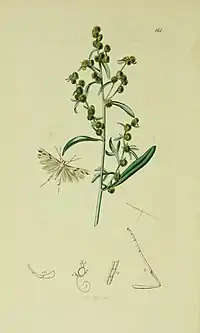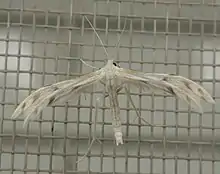Wheeleria spilodactylus
Wheeleria spilodactylus (the horehound plume moth) is a moth of the family Pterophoridae, first described by John Curtis in 1827. It is found in South-Western and Central Europe and the Mediterranean, Asia Minor and North Africa. It has been introduced to Australia as a biocontrol agent for white horehound (Marrubium vulgare).[1]

Illustration from John Curtis's British Entomology Volume 6

Depicted in William Buckler The larvæ of the British butterflies and moths 1901 Fig. 7 larva after final moult 7a pupa
| Wheeleria spilodactylus | |
|---|---|
 | |
| Scientific classification | |
| Kingdom: | |
| Phylum: | |
| Class: | |
| Order: | |
| Family: | |
| Tribe: | |
| Genus: | |
| Species: | W. spilodactylus |
| Binomial name | |
| Wheeleria spilodactylus Curtis, 1827 | |
| Synonyms | |
| |
The wingspan is 20–25 millimetres (0.79–0.98 in). Adults are on wing from July to September depending on the location.[2]
The difficult to see larvae feed on black horehound (Ballota nigra) and white horehound.
References
- "The release and establishment of two biological control agents of horehound (Marrubium vulgare L.) in south-eastern Australia". Weed information. Retrieved 2 August 2020.
- Kimber, Ian. "Wheeleria spilodactylus (Curtis, 1827)". UKmoths. Retrieved 2 August 2020.
This article is issued from Wikipedia. The text is licensed under Creative Commons - Attribution - Sharealike. Additional terms may apply for the media files.